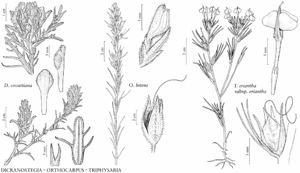Triphysaria
Index Seminum (St. Petersburg) 2: 52. 1836.
| Taxon | Illustrator ⠉ | |
|---|---|---|
 | Dicranostegia orcuttiana Orthocarpus luteus Triphysaria eriantha subsp. eriantha | John Myers Barbara Alongi Barbara Alongi |
Herbs, annual; hemiparasitic. Stems erect, not fleshy, glabrous or hairy. Leaves cauline, usually subopposite to opposite proximally, alternate distally; petiole absent; blade not fleshy, not leathery, margins entire (proximal cauline leaves) or pinnatifid, rarely bipinnatifid. Inflorescences terminal, spikelike racemes; bracts present. Pedicels present; bracteoles absent. Flowers: sepals 4, calyx bilaterally symmetric, tubular or campanulate, lobes triangular to narrowly lanceolate; petals 5, corolla yellow, white, purple, or white, fading to rose-pink, strongly bilabiate, tubular and club-shaped, abaxial lobes 3, saccate, throat folded proximal to abaxial lips (except in T. pusilla), adaxial 2, adaxial lip beaked, ± straight, opening directed forward; stamens 4, didynamous, filaments glabrous, pollen-sac 1; staminode 0; ovary 2-locular, placentation axile; stigma capitate, 2-lobed, or filiform to subcapitate. Capsules: dehiscence loculicidal. Seeds 10–100, dark-brown, ovoid to ellipsoid, wings absent. x = 11.
Distribution
w North America, in Asia (China)
Discussion
Species 5 (5 in the flora).
Taxa of Triphysaria have often been placed in Orthocarpus; both genera have adaxial corolla lips that are open at the tips (versus connate and folded downward forming a hood), expanded stigmas that are either capitate or two-lobed (versus unexpanded), and terminal attachments of the ovules to the placentas (versus lateral attachments). D. C. Tank and R. G. Olmstead (2008) found strong molecular support for their sister relationship. Triphysaria is distinguished from Castilleja by stamens with a single pollen sac (versus two), the throats of the corollas folded proximal to the abaxial corolla lips (except in T. pusilla), and the base chromosome number of 11.
Triphysaria pusilla has been introduced in China, where the name T. chinensis (D. Y. Hong) D. Y. Hong has been incorrectly applied to it (T. I. Chuang and L. R. Heckard 1991).
Selected References
None.
Lower Taxa
Key
| 1 | Stems: branches decumbent to ascending; corollas 4–7 mm, beaks hooked, abaxial lobes 0.5–1 mm. | Triphysaria pusilla |
| 1 | Stems: branches ascending; corollas 6–25 mm, beaks not hooked, abaxial lobes 1.5–5 mm. | > 2 |
| 2 | Stamens exserted; corollas creamy white, rarely pale yellow. | Triphysaria floribunda |
| 2 | Stamens included; corollas yellow, rarely yellow and white, or white, fading to rose pink. | > 3 |
| 3 | Stems sparsely pubescent distally; corolla beaks ± yellow, white, or rose pink. | Triphysaria versicolor |
| 3 | Stems puberulent to glandular-puberulent or pubescent to glandular-pubescent distally; corolla beaks dark purple, rarely yellow. | > 4 |
| 4 | Corollas 10–25 mm, abaxial lobes 2–5 mm. | Triphysaria eriantha |
| 4 | Corollas 10–12 mm, abaxial lobes 1.5–2 mm. | Triphysaria micrantha |